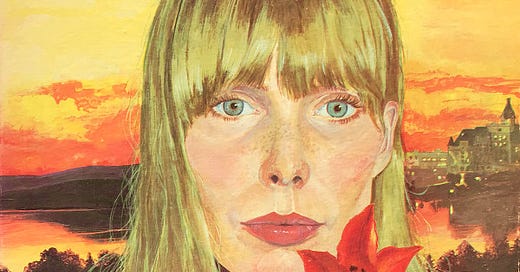In an interview in 1968, Joni Mitchell said –
… I always cop out in all my songs no matter how bleak they get, they have something at the end that said, “Well, there’s something lost be something gained in living every day.” Like even in Both Sides Now there is something at the end of each verse that sort of lifts it out of where it’s going. So, I still have some optimism left.
At this point, the song appeared on Judy Collins’s album Wildflowers in 1967 and became a hit in late 1968. Mitchell was already known for her poetic lyricism on her debut album Song to a Seagull - also released in 1968. It was 1969’s Clouds which cemented her reputation as one of her era's most talented and introspective singer-songwriters. It is the closing track ‘Both Sides Now’ which stands as the album’s highlight and points to the way that Mitchell would develop in her imperial phase of albums that include Blue (1971), Court and Spark (1974), The Hissing of Summer Lawns (1975) and 1976’s Hejira. The song profoundly reflects the dualities Mitchell mentions in the 1968 interview.
‘Both Sides Now’ presents a meditative reflection on life's illusions, a theme inspired by Mitchell's reading of Saul Bellow's Henderson the Rain King and a transcendent flight above the clouds.
Mitchell again;
I was reading Saul Bellow’s “Henderson the Rain King” on a plane and early in the book Henderson the Rain King is also up in a plane. He’s on his way to Africa and he looks down and sees these clouds. I put down the book, looked out the window and saw clouds too, and I immediately started writing the song. I had no idea that the song would become as popular as it did.
A flight over clouds also inspired another 1960s1 piece of art, Georgia O’Keeffe’s Sky above Clouds series.

The song uses the metaphor of clouds to explore the contrasting perspectives of innocence and experience. The lyrics oscillate between youthful idealism and the disillusionment often brought by maturity, encapsulating Mitchell's introspective examination of how experiences shape perception. Lines such as "I've looked at clouds from both sides now" reveal a shift from naïve enchantment to a more jaded, albeit wiser, viewpoint after Mitchell has literally seen the clouds from both below and now above.
The arrangement of ‘Both Sides Now’ is notably sparse, focusing on Mitchell's acoustic guitar and voice, which carry the song’s emotional weight. This instrumentational simplicity allows the lyrics' introspective quality to shine, creating a poignant and deeply personal listening experience to which we are privileged to be let in. Mitchell's guitar work on the track, influenced by her adaptation to a limited range of motion due to childhood polio, contributes to the distinctiveness of her sound, blending folk influences with a lyrical, almost conversational vocal style.
Produced by Paul A. Rothchild, known for his work with The Doors and Janis Joplin, the production of ‘Both Sides Now’ ensures that Mitchell's expressive vocals are at the forefront, allowing her poetic lyrics to resonate clearly. This song, placed at the album’s end, serves as a powerful conclusion to Clouds, tying together the album's themes of love, life, and illusion. Mitchell later revisited the track in 2000 with a lush orchestral arrangement, demonstrating her ongoing artistic evolution and the song's enduring relevance. The re-recorded song is also featured in one of the few sections of 2003’s Love Actually, which warrants five stars.2
‘Both Sides Now’ has been covered by numerous artists, including Judy Collins, whose successful version brought the song widespread acclaim before Mitchell's own recording was released. The song's insightful lyrics and memorable melody have made it a staple in Mitchell's repertoire, celebrated for its ability to articulate complex emotional landscapes.
Moreover, the song reflects Mitchell's broader impact on music and popular culture. Her exploration of personal and philosophical themes through accessible yet sophisticated songwriting has inspired countless artists and songwriters, including herself, and she has been one of the most influential figures in contemporary music.
and 1970s as well, the series wasn’t completed until 1977.
Billy Mack and Joe’s story and Jamie and Aurélia’s are also outstanding; most of the film’s runtime is devoted to dreck like the creepy Juliet, Peter, and Mark story or one-star efforts like Colin and Tony do America.




